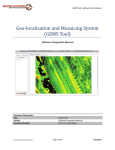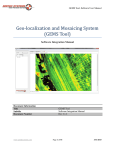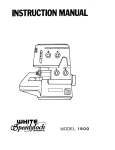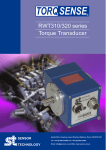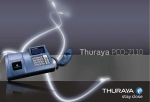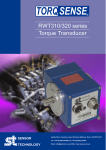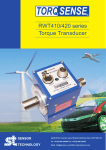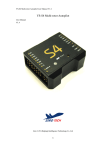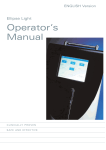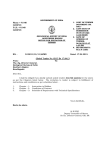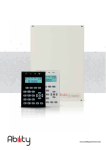Download GEMS Hardware Integration Manual Release 2.0.1 Final
Transcript
GEMS- Hardware Integration Manual Geo-localization and Mosaicing System GEMS Hardware Integration Manual Document Information Title Subtitle Document Number www.senteksystems.com GEMS Precision Agriculture Multispectral Payload Hardware Integration Manual Rev 2.0- initial release Page 1 of 25 8/19/2014 GEMS- Hardware Integration Manual Contents Preface .......................................................................................................................................................... 3 Warranty ....................................................................................................................................................... 3 Technical Support ......................................................................................................................................... 3 1. Hardware Description ........................................................................................................................... 4 1.1. Overview ........................................................................................................................................... 4 1.2. Architecture ...................................................................................................................................... 5 1.3. Performance Specifications .............................................................................................................. 6 1.4. Connecting power ............................................................................................................................. 7 1.5. Storage Media ................................................................................................................................... 7 1.6. Interface Cable .................................................................................................................................. 8 1.7. System Interfaces .............................................................................................................................. 8 1.7.1. GPIO .............................................................................................................................................. 8 1.7.2. UART.............................................................................................................................................. 8 1.7.3. USB ................................................................................................................................................ 8 1.7.4. HDMI ............................................................................................................................................. 9 2. GPS Antenna Recommendations & Installation ................................................................................... 9 2.1. Antenna Requirements ..................................................................................................................... 9 2.2. Antenna Installation Recommendations .......................................................................................... 9 3. GEMS Payload Installation .................................................................................................................. 11 4. LED Indicators ..................................................................................................................................... 16 4.1. Green LED.................................................................................................................................... 16 4.2. Blue LED ...................................................................................................................................... 17 4.3. Red LED ....................................................................................................................................... 17 5. Manual Mode Operation .................................................................................................................... 17 6. Safety .................................................................................................................................................. 18 6.1. RF Signals ........................................................................................................................................ 18 6.2. Product Handling ............................................................................................................................ 18 Appendix A: Abbreviations......................................................................................................................... 19 Appendix B: Calibration .............................................................................................................................. 20 Appendix C: Flight Planning Guidelines for GEMS ...................................................................................... 21 www.senteksystems.com Page 2 of 25 8/19/2014 GEMS- Hardware Integration Manual Preface As a part of our commitment to customer support Sentek has developed this user integration manual to provide technical documentation in addition to our GEMS product brochures and data sheet to aid the system integrator in proper installation of the GEMS payload. Warranty “e tek’s a a t o ligatio s fo this ha d a e p odu t a e li ited to the te s set fo th he ei : Sentek warrants this Sentek-branded hardware product against defects in materials and workmanship under normal use for a period of ONE (1) YEAR from the date of purchase by the original end-user pu hase Wa a t Pe iod . If a ha d a e defe t a ises a d a valid claim is received within the Warranty Period, at its option and to the extent permitted by law, Sentek will either (1) repair the hardware defect at no charge, using new or refurbished parts that are equivalent to new in performance and reliability, (2) exchange the product with a product that is new or refurbished that is equivalent to new in performance and reliability and is at least functionally equivalent to the original product. The warranty does not cover damage caused by accident, misuse or unauthorized repair, damage caused by impact, improper care or storage or leakage of batteries. The GEMS payload should be connected to an independent power source to maintain the payload is a non-mission critical system. Sentek Systems is not responsible and cannot be held liable for any damages if the payload is connected to the UAV main battery and made into a mission critical system. If modifications to the GEMS kit have been made (some examples, removing EMI shields on the payload, using a different jumpdrive than supplied in kit, removing or altering cameras, altering lenses or filters, using a different GPS antenna) the warranty is void and no longer valid and Sentek is not responsible for technically supporting these alterations. Obtaining Warranty Service: All shipping, insurance, duties and other incidental costs incurred to return the product to Sentek are at the expense of the owner of the product. Sentek will pay the cost of insured shipping only, FOB St. Louis Park MN USA when returning the product after completion of Warranty Service. All other expenses, duties, taxes and other incidental costs are at the expense of the owner. This warranty is in lieu of all other express or implied warranties and of any other obligation on the part of Sentek Systems LLC except for the obligations provided by applicable law. Technical Support For immediate technical assistance please email [email protected] this will automatically open a support ticket and be assigned to an application engineer. Additionally, our website (www.senteksystems.com) provides a contact us page that will email a representative who will contact an application engineer to assist with your technical needs. www.senteksystems.com Page 3 of 25 8/19/2014 GEMS- Hardware Integration Manual 1. Hardware Description 1.1. Overview GEMS is a precision agriculture multispectral sensor payload for remote sensing on small UAVs. It is designed to be a completely standalone hardware subsystem. The standalone design allows for ease of integration on any size and type of platform (fixed wing, rotary, or RC). The payload design is optimized for precision agriculture applications and is designed to optimize the following parameters: coverage rate, field of view, percent smear, platform altitude and velocity, image overlap for efficient mosaicing, frame rate, exposure time, and ground sampling distance (GSD). With the purchase of the GEMS hardware payload the GEMS software package is available free of charge. The software is designed to be utilized by either the end user or service provider on a ground based PC or laptop. The software will automatically access the sub-images recorded to the storage media (jump drive) from the flight and the corresponding metadata. The GEMS hardware captures RGB, NIR, and NDVI imagery in a single flight. Spectral bands (RGB, NIR, and NDVI) are aligned to sub-pixel level accuracies enabling fine details to be seen. The GPS WGS84 coordinates of an RGB, NIR, or NDVI pixel are obtained by hovering over the pixel with the mouse. Additionally, orthomosaiced imagery will be automatically generated in RGB and NIR as well as NDVI with GPS coordinates overlaid on the mosaiced imagery. For more technical detail on the GEMS software reference the Software user manual. Figure 1 Workflow Process Plug In • GEMS Hardware Power from UAV battery • USB jump drive • GPS antenna www.senteksystems.com Fly GEMS hardware on Platform Analyze GEMS Software • Automatically acquires GPS • • Automatically detects take off & landing events which activate cameras Plugin jump drive to ground PC or laptop • Aligns and Mosaics RGB, NIR & NDVI imagery • Geo-locates imagery • RGB, NIR, & NDVI imagery analyzed with GPS pixel coordinates in one flight • Automatically stores images to jump drive Page 4 of 25 8/19/2014 GEMS- Hardware Integration Manual 1.2. Architecture The payload is fully integrated with dual global shutter 1.3MP camera modules (RGB & NIR) that are precisely time synchronized to take imagery simultaneously. The camera data is tightly coupled with onboard inertial navigation sensors and a GPS subsystem. The tight integration of the cameras and the navigation provides precisely time synchronized metadata (i.e. camera position and orientation at the instant the image is taken) for each sub-image captured during the flight. The payload does not need to be integrated with any autopilot, GPS, or external sensors for aiding. The only inputs required for functionality are: power, GPS antenna, and storage media. Once the power is applied to the payload it is designed to automatically search for GPS and obtain a fix in under 35 seconds. There are LED indicators that blink when the payload is acquiring a fix and once locked on with a fix the LEDS turn solid green indicating the payload is flight ready. Once GPS is obtained the platform can immediately begin flight. In the GEMS default mode of operation the payload automatically detects the takeoff event, once the platform has reached 10 meters above the ground, and the camera is programmed to begin imagery acquisition with the sensor data acquisition. The payload automatically detects a landing event, once the platform has reached 3 meters above the ground, and stops collecting imagery and stores to the storage media. Once landed the LED indicators turn solid green indicating all data has been collected and stored and the power can be shut off to the payload and the storage media removed. Figure 2 GEMS Payload Hardware Contents www.senteksystems.com Page 5 of 25 8/19/2014 GEMS- Hardware Integration Manual 1.3. Performance Specifications Parameter Wavelengths Linear Acceleration Heading Accuracy** Yaw, Pitch, Roll Accuracy Camera Resolution Ground Sampling Distance (GSD) Field of View Frame Rate Time Synchronization Pixel Geo-location Accuracy GPS Time To First Fix (TTFF) Camera-to-camera Alignment Power Input Power Consumption Dimensions Weight Storage Media GPS Antenna GPIO Connector USB Connectors Power Connector Description Red centered at 615nm bandwidth FWHM = 114nm, Green centered 553nm FWHM = 101nm, Blue centered 450nm FWHM = 101nm, NIR centered at 810nm FWHM = 135nm (Custom filters available upon request) +/- 4g 0.15 degrees Yaw: 2 degrees, Pitch & Roll: 1.5 degrees 1.3MP RGB, 1.3MP Mono (1280x1024) 5.1cm @400ft, 2.5cm @200ft 30 degrees 1.4 (0.7 seconds between images) Images time synched (<1ms) with GPS & inertial data 3-5m*** (without field markers), 1.5cm* (with field markers) <35 seconds Spectral band aligned to sub-pixel accuracy 9-40V 0.4 Amps@12V, 4.8 Watts 3.5 x5 ith 4 mounting holes) 170grams (including shields) SanDisk Extreme 32GB USB jump drive provided with the GEMS kit. Upgrade to 64GB is available. GPS active antenna provided with GEMS kit. Min requirements 28dBi gain active antenna with SMAmale connector 7 pin picoblade designed for external LED extension cable 2 micro type A USB connectors for external storage media to plug into Molex single row 3mm pitch Micro-Fit 3.0 rated up to 5.0A with 600V AC Figure 3 Quick Reference Performance Specifications *Assumes field markers have been surveyed in to 1.5cm accuracy relative to a GPS RTK base station. The absolute position error of the base station must be added to the 1.5cm relative error to obtain the absolute position error of a pixel location. If field markers have been surveyed in with precise point positioning (PPP) GPS receivers absolute WGS84 pixel position accuracies of 10-20cm (single frequency PPP) or 1-5cm (dual frequency PPP receiver) are achievable. Achievable accuracy is GSD dependent. Release 1 GEMS Tool allows measurement through the GUI to 1-2 GSD. **Heading accuracy is velocity dependent 0.15degrees is at approximately 15m/sec. ***Altitude dependent; ~ 3-5m at 50-100ft www.senteksystems.com Page 6 of 25 8/19/2014 GEMS- Hardware Integration Manual 1.4. Connecting power The GEMS payload is designed to be powered from standard UAV/RC batteries. There is onboard power regulation that will accept a power range of DC input from 9-40 Volts. The payload has built in polarity mating (i.e. is polarity agnostic) to reduce hardware failures from reversing power and ground when plugged in incorrectly. The power connector is a Molex single row right angle thru hole connector with 3mm pitch. The contacts are fully isolated with a locking mechanism. The Micro-Fit 3.0 is rated up to 5.0 Amperes with a 600V AC rating. Sentek recommends to connect the GEMS payload to its own power source to maintain the payload is a non-mission critical system. Figure 4 Example of power polarity agnostic 1.5. Storage Media A SanDisk Extreme 32GB USB jump drive media storage device is provided with the GEMs payload. The jump drive is plugged into the interface cable which is connected to one of the micro USB connectors on the GEMS payload. For increased storage capabilities an upgrade to the SanDisk Extreme 64GB USB jump drive is available upon request. The current system is tested with the SanDisk Extreme which provides a max write speed of 100Mbytes/sec. Warning if the user does not use the two recommended jump drives Sentek cannot guarantee system performance speeds and system degradation may occur. www.senteksystems.com Page 7 of 25 Figure 5 Storage Media 8/19/2014 GEMS- Hardware Integration Manual 1.6. Interface Cable The interface cable plugs into the micro Type A connector on the GEMS Payload board and the other end plugs in the external storage media jump drive included with the GEMS system. Figure 6 Interface Cable 1.7. System Interfaces 1.7.1. GPIO There is one General Purpose Input output (GPIO) connector on the GEMS payload. This connector is a 6 pin picoblade Molex connector which supports 5 system indicator LEDs and one ground signal. An LED extension cable is provided as an accessory to the payload so that the end user can visualize the LEDS external to the embedded module in the platform. 1.7.2. UART There is one UART connector on the device which is currently not for use and is for future system upgrades. 1.7.3. USB There are two micro type A USB connectors on the device. One micro-USB is utilized for development purposes and the other is for the external storage media. An interface cable from microUSB to USB is provided with the device for the connection of the external jump drive. The storage media can be plugged into either microUSB and will work. www.senteksystems.com Page 8 of 25 8/19/2014 GEMS- Hardware Integration Manual 1.7.4. HDMI There is one HDMI connector on the device which is for development use only and not supported for end user applications. 2. GPS Antenna Recommendations & Installation 2.1. Antenna Requirements The selection and configuration of the GPS antenna is crucial in obtaining good GPS system performance. The recommended active GPS antenna should be used and installed according to this user integration manual to ensure optimal GPS performance. If a different GPS antenna is used Sentek cannot guarantee accurate reporting of GPS geo-location information. The minimum antenna specifications required is an antenna with omni-directional radiation pattern with a minimum gain of 28dBi. This is to ensure adequate C/N0 performance from the GPS satellites. Minimal cable lengths should be used to reduce loss in the system. The active antenna needs to have a male 50 Ohm SMA connector. Do not use a magnetic mount antenna; the magnet may skew the output of the magnetometer in the navigation system. Table 1 Nominal GPS Performance Specifications Parameter Average Time to First Fix (TTFF) Average Satellite Lock Average C/N0* Description <35 seconds coldstart to download ephemeris data 9-15 satellites lock fix 45 dBHz *This is an average C/N0 performance as seen in testing with proper ground plane installation and averaged nominally over 10 satellites in a clear sky environment. 2.2. Antenna Installation Recommendations It is highly recommended to ha e a i i u di e sio of 2 2 g ou d pla e. The ate ial should e highly conductive, for example, copper tape. The antenna should sit directly on top of the ground plane with no spacing or gap above the ground plane itself. If the antenna is sitting a distance above the ground plane distortion in the radiation pattern will occur and cause degradation to the GPS signal resulting in loss of GPS signal or increased probability of satellite dropout. The GPS antenna should be installed with a clear line of sight to the sky or under RF transparent material. Warning, if installed under www.senteksystems.com Page 9 of 25 8/19/2014 GEMS- Hardware Integration Manual a material it may detune the antenna from 50 Ohms and create degradation to GPS signal or increased dropout. Any additional antennas on the platform should be spaced as far away from the GPS antenna to minimize signal interference. All metal or conductive objects near the GPS antenna will impact performance and should be placed as far away as possible or under the ground plane. An example of good platform integration is to place the GPS antenna on the top of the platform away from all other electronics and metal, with a ground plane. All other communications links should be maximally far away with the other antennas on the bottom side of the platform with a ground plane barrier between the two antennas. Any bend of the RF coaxial cable feeding the antenna will reduce the signal to noise ratio and degrade performance. The RF coaxial cable feeding the antenna should have a large bend radius no right angles and when storing the cable/antenna do not bend the cable. Figure 7 Example of proper antenna install on ground plane (copper tape) on center topside of plane or quad away from other electronics. www.senteksystems.com Page 10 of 25 8/19/2014 GEMS- Hardware Integration Manual 3. GEMS Payload Installation Since GEMS is a navigation based mosaicing solution the payload installation is very important to obtaining good mosaicing results. Sentek strongly encourages all installation guidelines outlined below to be followed. As a part of the initial purchase of the system Sentek offers a free service that the UAV integrator sends a completed flight dataset to Sentek and our team of engineers provide plots of the platform effects on the payload inertial sensor data. Guidelines: The GEMS payload is designed to be installed with the cameras pointing downwards towards the ground. The payload should be installed so the device is maximally flat on the bottom of the vehicle. No ag eti aterial should e pla ed withi 4” fro the payload itself. This includes gimbals with stepper motors, steel screws, non-shielded motors. If you are unsure of a material being magnetic perform a simple magnet sweep on the components and your vehicle. Magnets will result in an iron anomaly in the magnetometer data and will show up on the mosaiced imagery as misalignments. Vibrations should be minimized. If installed on a fixed wing platform, it is recommended to place a foam barrier between the payload and motor for insulation from vibrations. If installed on a quad/hexcopter Sentek highly recommends using the Sentek custom designed enclosure. If this is not feasible, the payload should be mounted on the bottom of the platform with vibration isolators used to attach to the bottom of the enclosure. Custom designed foam enclosures to minimize shock and vibration have also worked well on some platforms. Vibrations generate noise on the accelerometers used in the payload and can effect mosaicing results. EMI should be reduced to minimize jamming GPS. In general this is always recommended for proper functioning of the GEMS payload and autopilots. Common noise sources on small UAVs are dirty power sources, non-shielded cables, and poorly designed OEM level printed circuit boards. The GPS antenna should be placed above rotors on quads with a sufficient ground plane size. If you are aware of a noise source on your platform try to move the noisy hardware as far away as possible from the payload and shield the noisy hardware with copper tape to produce a faraday cage like environment. The GEMS payload has EMI shields on it to prevent other UAV systems from interfering with our performance. www.senteksystems.com Page 11 of 25 8/19/2014 GEMS- Hardware Integration Manual Foam EMI Shields on payload prevent external sources from interfering with our sensors but also act as large heat sinks to our internal processor. We also fly with Foam inserted between payload and motors to dampen vibrations DO NOT REMOVE! (Warranty is void if removed) Figure 8 Example of payload in fuselage illustrating cameras pointing straight down towards ground. Vibration isolators Figure 9 GEMS Payload Enclosure mounted away from electronics with GEMS enclosure that contains vibration isolation mounts. www.senteksystems.com Page 12 of 25 8/19/2014 GEMS- Hardware Integration Manual USB storage media (can be utilized in either microUSB plugin) 4 Mounting holes for securing payload to platform Power connector GPS Antenna SMA Connector Figure 10 Connections needed for flying payload and mounting holes for securing payload to platform www.senteksystems.com Page 13 of 25 8/19/2014 GEMS- Hardware Integration Manual Examples of Good and Poor Payload/Platform Integration: Figure 11 Example of acceptable level of noise from vibrations on accelerometer data X-axis (red), Y-axis (green), Z-axis (blue) Figure 12 Example of Platform with unacceptable level of noise of accelerometer data X-axis (red), Y-axis (green), Z-axis (blue) www.senteksystems.com Page 14 of 25 8/19/2014 GEMS- Hardware Integration Manual Figure 13 Example of acceptable magnetometer data X-axis (red), Y-axis (green), Z-axis (blue) Figure 14 Example of unacceptable magnetometer data X-axis (red), Y-axis (green), Z-axis (blue) www.senteksystems.com Page 15 of 25 8/19/2014 GEMS- Hardware Integration Manual 4. LED Indicators The GEMS payload has 3 green LEDs, 1 red LED, and 1 blue LED that indicate to the user the operational state of the device. All states are indicated through the GPIO LED indication cable as well for ease of access on fixed wing platforms when the payload is embedded in a fuselage. Figure 15 LED indicators 4.1. Green LED The GEMS payload has 3 green LEDs that indicate to the user the payloads correct operational state of the device. The first green LED flashes until the system is properly initialized. Initialization is a series of events that includes GPS lock. Once initialization has occurred the first green LED stops flashing and turns solid green. The second green LED flashes while the system is recording and turns solid when recording is complete. The third green LED is off until the systems is done recording. It flashes while the system is finalizing the recording and turns solid green when the recording is finalized. Once the third LED is solid green the user can unmount the external jump drive and the user can turn the power off to www.senteksystems.com Page 16 of 25 8/19/2014 GEMS- Hardware Integration Manual the payload without effecting data. All 3 LEDS should be solid green after completion of a normal flight. Fight can begin after the first flashing green LED turns solid. The user can unmount the jump drive and turn off power to the payload once 3 solid green LEDs are visible. 4.2. Blue LED The blue LED is to indicate manual mode operation refer to section 5 for details. In manual mode operation the blue LED will be continuously illuminated. This is the only time the user should ever see a blue LED indicator. 4.3. Red LED The red LED is used to indicate error. The red LED will flash during initialization if there is no jump drive detected. If a jump drive is missing, the payload should be powered down and the jump drive should be connected then power can be delivered to the payload. This will ensure the proper initialization sequence of the payload with the storage media. If the red LED is solid and not flashing this is an indication of a critical failure. This may be due to the jump drive not having enough storage space. The jump drive should be cleared from the previous flight and re-connected to the payload with a proper power cycle. If the solid red LED is seen after this process is completed contact an application engineer through technical support. 5. Manual Mode Operation The GEMS payload default configuration is to automatically detect take-off and landing events and the cameras will be triggered according to this configuration. In the event the user does not want the system to detect takeoff and landing there is a bypass configuration in which the payload will operate in manual mode. With a single press of the pushbutton the user will enable the manual mode operation. Once the pushbutton has been enabled the system will immediately start recording and will not stop recording until the pushbutton is pressed again. This mode of operation is for use cases in which the user is flying very low, has intermittent landings and still wants to record, or the payload is not on an aerial vehicle and is lower to the ground. www.senteksystems.com Page 17 of 25 8/19/2014 GEMS- Hardware Integration Manual 6. Safety Safety precautions should be employed when handling scientific equipment. GEMS has integrated standard practice safety measures to reduce the exposure of electrostatic discharge. RF Shields have been integrated over the PCB to reduce electromagnetic interference with the device and from the device to other devices as well as to mitigate ESD from the system integrators human exposure to the PCB. This protects the electronics from damage. All connectors are mated with polarity markers and the SMA RF connector is female to ensure no active power from the board to an end user. 6.1. RF Signals GPS signals are receiving radio frequency electromagnetic waves. 6.2. Product Handling OEM boards are sensitive to Electrostatic Discharge (ESD). Special precautions are required when handling. When handling attempt to install the device with minimal human contact with the electronic components to prevent electronic component damage. www.senteksystems.com Page 18 of 25 8/19/2014 GEMS- Hardware Integration Manual Appendix A: Abbreviations Abbreviation Definition GEMS GPS CN0 SNR dB USB HDMI UART GPIO EMI EMC ESD LED TTFF PPP RTK PCB OEM SMA RF UAV Geo-localization Mosaicing System Global Positioning Satellites Carrier to Noise Ratio Signal to Noise Ratio Decibels Universal Serial Bus High Definition Multimedia Interface Universal Asynchronous Receiver/Transmitter General Purpose Input Output Electromagnetic Interference Electromagnetic Compatibility Electromagnetic Discharge Light Emitting Diode Time To First Fix Precise Point Positioning Real Time Kinematic Printed Circuit Board Original Equipment Manufacturer Sub Miniature Version A Radio Frequency Unmanned Aerial Vehicle www.senteksystems.com Page 19 of 25 8/19/2014 GEMS- Hardware Integration Manual Appendix B: Calibration Calibration of all measurement sensors on the GEMS payload have been performed on each unit prior to shipment. If the GEMS sensor is involved in a serious crash the GEMS payload may be damaged and sensor calibration values may be altered thereby impacting sensor performance. Sentek Systems offers a GEMS repair and calibration service to ensure optimized performance of the GEMS payload. Support engineers are available to determine if this procedure needs to be performed. www.senteksystems.com Page 20 of 25 8/19/2014 GEMS- Hardware Integration Manual Appendix C: Flight Planning Guidelines for GEMS Introduction GEMS is a self-contained, multi-spectral camera with a built-in, tightly integrated navigation system. The cameras and optics are selected and calibrated to measure relative NDVI (Normalized Difference Vegetation Index) from the air. The system handles the alignment of spectral bands, geo-registration of the imagery, image processing and analysis to render vivid NDVI imagery in false-color, and stitching collected imagery into geo-referenced, ortho-rectified RGB, NIR, and NDVI moasics. These capabilities are provided through our software suite that is included with the GEMS payload. As a self-contained sensor, GEMS does not need to be integrated with external navigation systems, autopilots, or triggering systems. The system is powered up on the ground, where it will acquire GPS and initialize all of its onboard sensors (typically in under 35 seconds). Once the system is initialized, it will wait and monitor data from its sensors until it detects a take-off event. When it detects that is has taken off it will begin recording imagery and navigation data and will continue until it detects that you have landed. It will then power itself down and the collected data is conveniently available on a removable thumbdrive. While GEMS autonomously handles tasks like take-off and landing detection and camera triggering, it does not control what it is flown over, so there are some guidelines to follow when planning your flight to make sure you get proper coverage and the best possible imagery from the GEMS payload. Flight Pattern While no specific flight pattern is required in order to use GEMS, if you are trying to collect imagery of large areas (as opposed to linear stretches of land), we recommend flying a serpentine pattern as shown in Fig 1. If flying in a fixed-wing vehicle that tends to roll in turns, it is a good practice to overfly the area of interest at the end of each row and fly a little beyond the perimeter of the field. This ensures that you get good coverage of the entire region of interest. The choice of row spacing depends on your height above ground described below. www.senteksystems.com Page 21 of 25 8/19/2014 GEMS- Hardware Integration Manual Figure 16 recommended flight pattern when covering 2D areas. Flight Profile and Row Spacing The height at which you fly your vehicle is an important parameter which has a direct effect on the ground resolution of the collected imagery (your GSD1) and the time it takes to cover any given area (your coverage rate). Put simply, flying lower and slower gives you finer resolution on the ground (smaller GSD) while flying higher and faster increases your coverage rate. Fig 2 shows the GSD as a function of height for the GEMS payload. Figure 17 Ground sampling distance versus height www.senteksystems.com Page 22 of 25 8/19/2014 GEMS- Hardware Integration Manual In addition to affecting GSD, the height and speed of your vehicle affects the amount of motion blur (or image smear) in the collected imagery and the amount of image-to-image overlap, which in turn affects the reliability and quality of automatic image stitching. Figure 3 shows which combinations of speed and height result in good, crisp imagery with sufficient image-to-image overlap to enable automatic image stit hi g. E e p ofile i oth the Good a d OK regions results in very low motion blur (in fact, in typical daylight conditions many profiles outside of these regions will also give crisp images). The diffe e e et ee the Good a d OK egio s is dete i ed the a ou t of i age-to-image o e lap the e tail. The OK egio esults i o e laps et ee 0% a d 70%, hile the Good egio results in overlaps above 70%. The amount of image overlap that is required for robust automatic image stitching depends greatly on the content of the imagery. In a lot of generic aerial imagery there tends to be a great deal of distinctiveness between images. That is, there are many interesting features that make it easier to align different images. In this case, overlaps of 50% are often perfectly sufficient for robust automatic stitchi g, a d a p ofile i eithe the Good o OK egio s ill suffi e. I i sta es where there is not a lot of distinctiveness between images, which can be the case in some agricultural applications, greater image-to-image overlap may be needed for robust stitching. In these situations we e o e d e plo i g a flight p ofile falli g i the Good egio . I additio to dete i i g a epta le speeds, vehicle height also determines what row spacings can be used when flying a serpentine pattern (see Fig 2) to enable robust automatic image stitching. Figure 4 shows which combinations of row spa i g a d height esult i OK a d Good o e lap. Agai , hi h egio to shoot fo depe ds o the content of the imagery. 1 Ground Sampling Distance (GSD) is the linear distance between the points on the ground seen by adjacent pixels in your cameras focal plane array. If your GSD is 2 cm, it means that a single pixel in your imagery 2 sees a region on the ground of size 2 cm x 2 cm (an area of 4 cm ). Important Note: We do not recommend flying below 15 ft because beneath this height there is a risk that the imagery will not be entirely in focus. Also, if flying below 40 ft, there is a chance that the system may have difficulty accurately detecting take-off and landing events (e.g. it may think you have landed if ou a e ho e i g at lo altitude . If ou fl elo 0 ft, e e o e d usi g the a ual e o di g mode to ensure that you do not run into problems with this feature (refer to the user manual for details). www.senteksystems.com Page 23 of 25 8/19/2014 GEMS- Hardware Integration Manual Figure 18 Recommended flight profiles Figure 19 Recommended row spacing versus height www.senteksystems.com Page 24 of 25 8/19/2014 GEMS- Hardware Integration Manual Parameters for Flight Planning Software If you use additional software for flight planning, you may need to provide it with some information about your imaging system so it can set an appropriate flight plan. When using tools such as these, set your overlap target to an appropriate value for your subject matter (if you are unsure, start with 70%). The system will collect images automatically at a rate around 0.7-0.9 seconds between images. Enter the following values as needed: Image sensor resolution: 1280 x 960 pixels Sensor dimensions (active area): 4.8 x 3.6 mm Pixel size: 3.75 x 3.75 μm Horizontal Field of View: 34.622 deg Vertical Field of View: 26.314 deg Focal length: 7.70 mm “o e tools a e ui e o e detailed i fo atio a out ou se so a d opti s. The I t i si Cali atio Mat i , so eti es also alled the Ca e a Cali atio Mat i , a d f e ue tl de oted K is: �= ( . . . . . . 9. 9. . ) The GEMS payload uses low-distortion optics and for the purpose of flight planning any distortion (radial and tangential) can be assumed negligible. www.senteksystems.com Page 25 of 25 8/19/2014

























